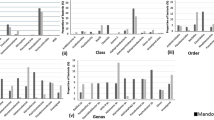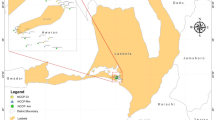Abstract
Indian lotus (Nelumbo nucifera) is one of the dominant aquatic plants cultivated in Dal Lake, situated at 1586 m above mean sea level (MSL) in the northeast of Srinagar, Kashmir. Despite their economic and ecological role, the microbial communities associated with the lotus plant are still unexplored. In this study, we investigated the prokaryotic communities on surfaces of different lotus microhabitats (roots, rhizome, leaves, flowers, and fruits), lake water, and sediments using 16S rRNA gene amplicon sequencing. Overall, prokaryotic diversity decreased significantly on the surface of lotus microhabitats in comparison to the lake water and sediments. Among the microhabitats of lotus, roots and leaves harbored more diverse communities in comparison to rhizomes, fruits, and flowers. A total of 98 genera were shared by lotus and the Dal Lake sediments and water. However, significant differences were found in their relative abundance; for example, Pseudomonas was the most dominant genus on the majority of lotus microhabitats. On the other hand, Flavobacterium was highly abundant in the lake water, while a higher abundance of Acinetobacter was recorded in sediments. Additionally, we also noted the presence of potential human pathogenic genera including Escherichia-Shigella, Enterobacter, Pantoea, Raoultella, Serratia, and Sphingomonas on the lotus microhabitats. Predicted functions of prokaryotic communities revealed a higher abundance of genes associated with nutrient uptake in the microhabitats of the lotus. This study offered first-hand information on the prokaryotic communities harbored by lotus plants and water and sediments of the Dal Lake and demonstrated the adaptation of diverse communities to microhabitats of lotus.






Similar content being viewed by others
Data availability
The sequence data is available at NCBI SRA submission with SRA no. SRP335402.
Abbreviations
- PCoA :
-
Principal co-ordinate analysis
- NMDS :
-
Non-metric multidimensional scaling
- OTUs :
-
Operational taxonomic unit
- ANOVA :
-
Analysis of variance
References
Ahmad T, Gupta G, Sharma A, Kaur B, Alsahli AA, Ahmad P (2020) Multivariate statistical approach to study spatiotemporal variations in water quality of a Himalayan urban fresh water lake. Water 12(9):2365. https://doi.org/10.3390/w12092365
Aßhauer KP, Wemheuer B, Daniel R, Meinicke P (2015) Tax4Fun: predicting functional profiles from metagenomic 16S rRNA data. Bioinform 31(17):2882–2884. https://doi.org/10.1093/bioinformatics/btv287
Bhat T (2013) Physicochemical characteristics of Dal Lake under temperate conditions of Kashmir (Jammu and Kashmir), India. Int J Curr Sci 9:133–136
Bhattacharjee B, Lakshminarasimhan P (2018) A description of N.nucifera; Central National Herbarium: Howrah, 2018.
Caporaso JG, Kuczynski J, Stombaugh J et al (2010) QIIME allows analysis of high-throughput community sequencing data. Nat Method 7:335–336. https://doi.org/10.1038/nmeth.f.303
Chaudhari D, Rangappa K, Das A et al (2020) Pea (Pisum sativum l.) plant shapes its rhizosphere microbiome for nutrient uptake and stress amelioration in acidic soils of the north-east region of India. Fron Microbiol 11:968. https://doi.org/10.3389/fmicb.2020a.00968
Chaudhari DS, Dhotre DP, Jani K et al (2020b) Bacterial communities associated with the biofilms formed in high-altitude brackish water Pangong Tso located in the Himalayan Plateau. Curr Microbiol 77:4072–4084. https://doi.org/10.1007/s00284-020-02244-4
Chen K-L, Kirschner R (2017) Fungi from leaves of lotus (Nelumbo nucifera). Mycol Prog 17:275–293. https://doi.org/10.1007/s11557-017-1324-y
Chen S, Waghmode TR, Sun R et al (2019) Root-associated microbiomes of wheat under the combined effect of plant development and nitrogen fertilization. Microbiome 7 https://doi.org/10.1186/s40168-019-0750-2
Chen X, Krug L, Yang M et al (2021) The Himalayan onion (Allium wallichii Kunth) harbors unique spatially organized bacterial communities. Microb Ecol https://doi.org/10.1007/s00248-021-01728-5
Compant S, Samad A, Faist H, Sessitsch A (2019) A review on the plant microbiome: ecology, functions, and emerging trends in microbial application. J Adv Res 19:29–37. https://doi.org/10.1016/j.jare.2019.03.004
Djemiel C, Maron PA, Terrat S et al (2022) Inferring microbiota functions from taxonomic genes: a review. GigaScience 11:giab090. https://doi.org/10.1093/gigascience/giab090
Edgar RC (2010) Search and clustering orders of magnitude faster than BLAST. Bioinform 26:2460–2461. https://doi.org/10.1093/bioinformatics/btq461
Egamberdieva D, Wirth SJ, Alqarawi AA et al (2017) Phytohormones and beneficial microbes: essential components for plants to balance stress and fitness. Front Microbiol 8:2104. https://doi.org/10.3389/fmicb.2017.02104
Eiler A, Bertilsson S (2007) Flavobacteria blooms in four eutrophic lakes: linking population dynamics of freshwater bacterioplankton to resource availability. Appl Environ Microbiol 73:3511–3518. https://doi.org/10.1128/AEM.02534-06
García-Llorente M, Martín-López B, Díaz S, Montes C (2011) Can ecosystem properties be fully translated into service values? An economic valuation of aquatic plant services. Ecol Appl 21:3083–3103
Gomba A, Chidamba L, Korsten L (2017) Effect of postharvest practices including degreening on citrus carpoplane microbial biomes. J Appl Microbiol 122:1057–1070. https://doi.org/10.1111/jam.13396
Gowthami R, Sharma N, Pandey R et al (2021) A model for integrated approach to germplasm conservation of Asian lotus (Nelumbo nucifera Gaertn.). Genet Resour Crop Evol 68:1269–1282. https://doi.org/10.1007/s10722-021-01111-w
Goudarzi A (2019) The recent insights into the function of ACAT1: a possible anti-cancer therapeutic target. Life Sci 232:116592
Hammer Ø, Harper DA, Ryan PD (2001) PAST: paleontological statistics software package for education and data analysis. Palaeontol Electr 4:9
Hamonts K, Trivedi P, Garg A et al (2018) Field study reveals core plant microbiota and relative importance of their drivers. Environ Microbiol 20(1):124–140. https://doi.org/10.1111/1462-2920.14031
Holmer M, Laursen L (2002) Effect of shading of Zostera marina (eelgrass) on sulfur cycling in sediments with contrasting organic matter and sulfide pools. J Exp Mar Biol Ecol 270:25–37. https://doi.org/10.1016/s0022-0981(02)00015-1
Ke J, Wang B, Yoshikuni Y (2021) Microbiome engineering: synthetic biology of plant-associated microbiomes in sustainable agriculture. Trend Biotechnol 39(3):244–261. https://doi.org/10.1016/j.tibtech.2020.07.008
Köberl M, Erschen S, Etemadi M et al (2019) Deciphering the microbiome shift during fermentation of medicinal plants. Sci Rep 9:49799. https://doi.org/10.1038/s41598-019-49799-2
Li Y, Sun Y, Zhang H et al (2019) The responses of bacterial community and N2O emission to nitrogen input in lake sediment: estrogen as a co-pollutant. Environ Res 179:108769
Macdonald C, Singh B (2014) Harnessing plant-microbe interactions for enhancing farm productivity. Bioengineered 5(1):5–9. https://doi.org/10.4161/bioe.25320
Macias-Benitez S, Garcia-Martinez AM, Caballero Jimenez P, Gonzalez JM, Tejada Moral T, Parrado Rubio J (2020) Rhizospheric organic acids as biostimulants: monitoring feedbacks on soil microorganisms and biochemical properties. Front Plant Sci 11:633. https://doi.org/10.3389/fpls.2020.00633
Magoč T, Salzberg SL (2011) FLASH: fast length adjustment of short reads to improve genome assemblies. Bioinformatics 27(21):2957–2963. https://doi.org/10.1093/bioinformatics/btr507
Matthews PGD, Seymour RS (2006) Anatomy of the gas canal system of Nelumbo nucifera. Aqua Bot 85:147–154. https://doi.org/10.1016/j.aquabot.2006.03.002
Meeboon J, Takamatsu S (2015) Erysiphe takamatsui, a powdery mildew of lotus: rediscovery of teleomorph after 40 years, morphology and phylogeny. Mycosci 56:159–167. https://doi.org/10.1016/j.myc.2014.05.002
Michaud L, Caruso C, Mangano S, Interdonato F, Bruni V, Giudice AL (2012) Predominance of Flavobacterium, Pseudomonas, and Polaromonas within the prokaryotic community of freshwater shallow lakes in the northern Victoria Land, East Antarctica. FEMS Microbiol Ecol 82:391–404. https://doi.org/10.1111/j.1574-6941.2012.01394.x
Mishra V, Pathak V, Tripathi B (2009) Accumulation of cadmium and copper from aqueous solutions using Indian lotus (Nelumbo nucifera). AMBIO J Human Environ 38:110–112
Mitter EK, de Freitas JR, Germida JJ (2017) Bacterial root microbiome of plants growing in oil sands reclamation covers. Front Microbiol 8:849. https://doi.org/10.3389/fmicb.2017.00849
Moon CD, Young W, Maclean PH et al (2018) Metagenomic insights into the roles of Proteobacteria in the gastrointestinal microbiomes of healthy dogs and cats. Microbiol Open 7:e00677. https://doi.org/10.1002/mbo3.677
Massoni J, Bortfeld-Miller M, Jardillier L et al (2020) Consistent host and organ occupancy of phyllosphere bacteria in a community of wild herbaceous plant species. ISME J 14:245–258. https://doi.org/10.1038/s41396-019-0531-8
Nielsen LB, Finster K, Welsh DT et al (2001) Sulphate reduction and nitrogen fixation rates associated with roots, rhizomes and sediments from Zostera noltii and Spartina maritima meadows. Environ Microbiol 3:63–71. https://doi.org/10.1046/j.1462-2920.2001.00160.x
Rahi P (2017) Phytomicrobiome: a reservoir for sustainable agriculture. In: Kalia VC, Shouche Y, Purohit HJ, Rahi P (eds) Mining of Microbial Wealth and MetaGenomics. Springer, Singapore, pp 117–132
Rahi P, Giram P, Chaudhari D et al (2020) Rhizobium indicum sp nov, isolated from root nodules of pea (Pisum sativum) cultivated in the Indian trans-Himalayas. Sys App Microbiol 43:126127. https://doi.org/10.1016/j.syapm.2020.126127
Rashid I, Romshoo SA, Amin M, Khanday SA, Chauhan P (2017) Linking human-biophysical interactions with the trophic status of Dal Lake, Kashmir Himalaya, India. Limnologica 62:84–96. https://doi.org/10.1016/j.limno.2016.11.008
Rasid NA, Naim MN, Man HC, Bakar NA, Mokhtar MN (2019) Evaluation of surface water treated with lotus plant Nelumbo nucifera. J Environ Chem Engineer 7(3):103048. https://doi.org/10.1016/J.JECE.2019.103048
Ren X-M, Guo S-J, Tian W et al. (2019) Effects of plant growth-promoting bacteria (PGPB) inoculation on the growth, antioxidant activity, cu uptake, and bacterial community structure of rape (Brassica napus L.) grown in Cu-contaminated agricultural soil. Front Microbiol 10: 1455. https://doi.org/10.3389/fmicb.2019.01455
Rodriguez PA, Rothballer M, Chowdhury SP et al (2019) Systems biology of plant-microbiome interactions. Mol Plant 12:804–821. https://doi.org/10.1016/j.molp.2019.05.006
Seymour RS, Schultze-Motel P (1996) Thermoregulating Lotus Flowers Nat 383:305
Shah JA, Pandit AK, Farooq S (2014) Periphytic algal community of Dal Lake in Kashmir valley, India. Res J Environ Sci 8:391–398. https://doi.org/10.3923/rjes.2014.391.398
Shahid MJ, AL-surhanee AA, Kouadri F et al (2020) Role of microorganisms in the remediation of wastewater in floating treatment wetlands: a review. Sustain 12:5559. https://doi.org/10.3390/su12145559
Singh T, Awasthi G, Tiwari Y (2021) Recruiting endophytic bacteria of wetland plants to phytoremediate organic pollutants. Int J Environ Sci Technol. https://doi.org/10.1007/s13762-021-03476-y
Sivakumar N, Sathishkumar R, Selvakumar G et al (2020) Phyllospheric microbiomes: diversity, ecological significance, and biotechnological applications. in: Yadav, A., Singh, J., Rastegari, A., Yadav, N., (Eds) Plant microbiomes for sustainable agriculture. Sustainable Development and Biodiversity, 25. Springer, Cham. https://doi.org/10.1007/978-3-030-38453-1_5
Sun Y, Wang M, Mur LAJ et al (2021) The cross-kingdom roles of mineral nutrient transporters in plant-microbe relations. Physiol Plant 171(4):771–784
Szymańska S, Sikora M, Hrynkiewicz K et al (2021) Choosing source of microorganisms and processing technology for next generation beet bioinoculant. Sci Rep 11. https://doi.org/10.1038/s41598-021-82436-5
Vyas P, Rahi P, Gulati A (2009) Stress tolerance and genetic variability of phosphate-solubilizing fluorescent Pseudomonas from the cold desert of the trans-Himalayas. Microb Ecol 58:425–434
Wang Y, Guo M, Li X et al (2022) Shifts in microbial communities in shallow lakes depending on trophic states: Feasibility as an evaluation index for eutrophication. Ecol Indicators 136:108691. https://doi.org/10.1016/j.ecolind.2022.108691
Wang J, Chen H, Sui T, Li A, Chen D (2009) Investigation on hydrophobicity of lotus leaf: experiment and theory. Plant Sci 176:687–695. https://doi.org/10.1016/j.plantsci.2009.02.013
Wang W, Ma Y, He J et al (2019) Gene regulation for the extreme resistance to ionizing radiation of Deinococcus radiodurans. Gene 715:144008. https://doi.org/10.1016/j.gene.2019.144008
Wang Y, Wang C (2020) Comparative study on archaeal diversity in the sediments of two urban landscape water bodies. PLoS One 15:e0229097. https://doi.org/10.1371/journal.pone.0229097
Yamamoto K, Shiwa Y, Ishige T et al (2018) Bacterial diversity associated with the rhizosphere and endosphere of two halophytes: Glaux maritima and Salicornia europaea. Front Microbiol 9:2878. https://doi.org/10.3389/fmicb.2018.02878
Yurgel SN, Douglas GM, Dusault A et al (2018) Dissecting community structure in wild blueberry root and soil microbiome. Front Microbiol 9:1187. https://doi.org/10.3389/fmicb.2018.01187
Acknowledgements
The authors acknowledge the Director, NCCS, Pune.
Funding
This work was supported by funding from the Department of Biotechnology (BT/Coord. II/01/03/2016), Government of India. B.A.M. also acknowledges the funding under Energy Bioscience Overseas Fellowship.
Author information
Authors and Affiliations
Corresponding author
Ethics declarations
Conflict of interest
The authors declare no competing interests.
Additional information
Publisher's note
Springer Nature remains neutral with regard to jurisdictional claims in published maps and institutional affiliations.
Supplementary Information
Below is the link to the electronic supplementary material.
Rights and permissions
Springer Nature or its licensor (e.g. a society or other partner) holds exclusive rights to this article under a publishing agreement with the author(s) or other rightsholder(s); author self-archiving of the accepted manuscript version of this article is solely governed by the terms of such publishing agreement and applicable law.
About this article
Cite this article
Chaudhari, D., Kiran, S., Choudhary, A. et al. Prokaryotic communities adapted to microhabitats on the Indian lotus (Nelumbo nucifera) growing in the high-altitude urban Dal Lake. Int Microbiol 26, 257–267 (2023). https://doi.org/10.1007/s10123-022-00297-y
Received:
Revised:
Accepted:
Published:
Issue Date:
DOI: https://doi.org/10.1007/s10123-022-00297-y




